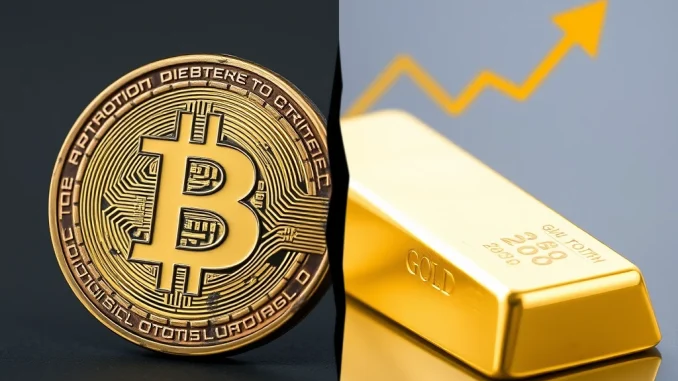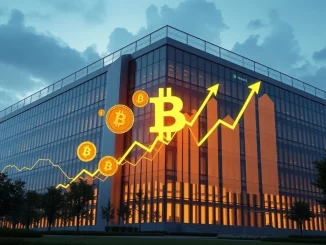
Is the king of crypto, Bitcoin, starting to lose its luster as the ultimate ‘digital gold’? Recent analysis from financial giant JPMorgan suggests a fascinating shift in investor sentiment. It seems the volatile nature of Bitcoin and its close dance with tech stocks are pushing investors towards a more traditional safe haven: gold. Let’s dive into why this is happening and what it means for the future of cryptocurrency as a hedge.
Is Bitcoin’s ‘Digital Gold’ Narrative Fading?
For years, Bitcoin has been championed as ‘digital gold’ – a modern alternative to the precious metal, offering a hedge against inflation and currency debasement. However, JPMorgan analysts are now pointing to a significant weakening of this narrative. Why? The culprit seems to be volatility. Bitcoin’s price swings are notorious, often far exceeding those of traditional assets like gold. This inherent volatility makes some investors, particularly those seeking stability during economic uncertainty, understandably nervous.
Adding fuel to the fire is Bitcoin’s strong correlation with tech stocks. In recent times, Bitcoin’s price movements have mirrored those of tech-heavy indices like the Nasdaq. This correlation undermines its appeal as a true diversifier, as a safe haven asset should ideally move independently of, or even inversely to, riskier assets like tech stocks during market downturns. When tech stocks wobble, Bitcoin often stumbles right along with them, diminishing its perceived safety.
Gold’s Glitter Reappears: The Traditional Safe Haven
While Bitcoin grapples with its identity crisis, old faithful gold is experiencing a resurgence. Investors are increasingly turning back to physical gold as a reliable safe haven asset. Gold has a long and storied history as a store of value, particularly during times of economic turmoil and inflationary pressures. Unlike Bitcoin, gold’s value isn’t tied to the performance of tech companies or the whims of the crypto market. It’s a tangible asset with intrinsic value, perceived as a stable anchor in stormy seas.
This renewed interest in gold is clearly reflected in investment flows. Spot Bitcoin ETFs, which were once hailed as a game-changer for crypto adoption, are now witnessing outflows. Investors are pulling their funds out of these Bitcoin-based investment products. Conversely, gold ETFs are seeing inflows, indicating a clear shift in investor preference. This movement of capital speaks volumes about the current market sentiment and the evolving perception of Bitcoin and gold as safe havens.
Why are Investors Shifting to Gold Now?
- Inflation Concerns: Inflation remains a persistent worry globally. Gold has historically been used as an inflation hedge, maintaining its purchasing power over long periods, making it attractive when fiat currencies are losing value.
- Currency Debasement Fears: Concerns about government debt and potential currency debasement also drive investors towards gold. As governments print more money, the value of fiat currencies can erode, and gold is seen as a way to protect wealth against this erosion.
- Geopolitical Uncertainty: Global geopolitical tensions and economic uncertainties further amplify the appeal of gold. In times of crisis, investors tend to flock to safe, liquid assets, and gold fits this bill perfectly.
- Perceived Stability: Compared to the relatively nascent and volatile cryptocurrency market, gold offers a sense of stability and predictability that many investors crave, especially in uncertain times.
JPMorgan’s Perspective: What’s Bitcoin Really Worth?
Despite the current headwinds, JPMorgan still sees value in Bitcoin, albeit with a risk-adjusted lens. Their analysts estimate Bitcoin’s fair value to be around $71,000 when adjusting for risk. This suggests that even with its volatility, Bitcoin has fundamental value. However, they also highlight a historical price floor of $62,000 for Bitcoin. This price floor could represent a level of strong support, but also underscores the potential downside risk associated with the cryptocurrency.
Key Takeaways: Bitcoin vs. Gold in the Current Market
| Feature | Bitcoin | Gold |
|---|---|---|
| Status as ‘Digital Gold’ | Weakening due to volatility and tech stock correlation | Traditional safe haven, regaining favor |
| Volatility | High | Lower |
| Correlation with Tech Stocks | Strong | Low |
| ETF Flows | Outflows | Inflows |
| Hedge against Inflation | Questionable in the short-term due to volatility | Historically proven |
| JPMorgan’s Risk-Adjusted Value | ~$71,000 | N/A (Valued based on market prices and demand) |
| Historical Price Floor (JPMorgan) | ~$62,000 | N/A |
Navigating the Shifting Sands: What Should Investors Do?
The evolving dynamics between Bitcoin and gold highlight the importance of portfolio diversification and understanding risk tolerance. While Bitcoin still holds long-term potential, its current volatility and correlation with tech stocks make it a less reliable safe haven in the short-term compared to gold. For investors seeking stability and a hedge against traditional market risks, gold might be the more secure choice right now.
However, the crypto landscape is constantly evolving. Bitcoin’s narrative could shift again, particularly if it can decouple from tech stock movements and demonstrate greater stability. Ultimately, the decision of whether to favor Bitcoin or gold (or both) depends on individual investment goals, risk appetite, and market outlook. Keeping a close eye on market trends and expert analysis, like that from JPMorgan, is crucial for making informed investment decisions in this dynamic environment.
In conclusion, the spotlight is currently shifting, with gold reclaiming its traditional safe haven status while Bitcoin faces questions about its ‘digital gold’ narrative. This isn’t necessarily the end of Bitcoin’s story, but it’s a critical juncture that investors need to understand to navigate the market effectively. The interplay between these two assets will undoubtedly continue to be a fascinating aspect of the financial world.



